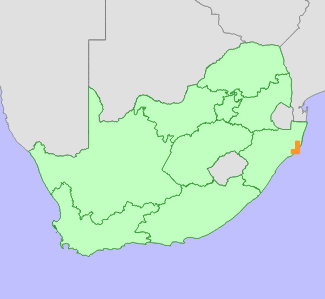|
Scientific Name | Asclepias gordon-grayae Nicholas |
Higher Classification | Dicotyledons |
Family | APOCYNACEAE |
National Status |
Status and Criteria | Endangered B1ab(iii) |
Assessment Date | 2007/07/30 |
Assessor(s) | A. Nicholas, L. von Staden & J.E. Victor |
Justification | A range-restricted species (EOO 1 400 km²), recorded from five locations with continuing decline as a result of afforestation, subsistence and commercial crop cultivation and open-cast mining. Coastal grasslands between Ngoye and St. Lucia are 64% transformed. |
Distribution |
Endemism | South African endemic |
Provincial distribution | KwaZulu-Natal |
Range | Ngoye to St. Lucia. |
Habitat and Ecology |
Major system | Terrestrial |
Major habitats | Maputaland Wooded Grassland, Maputaland Coastal Belt |
Description | Tall, unburnt coastal grassland, in black peat soils in marshy areas, 10-100 m. |
Threats |
| The habitat of this species is severely threatened by forestry, agriculture and open cast mining (Nicholas 1999) and habitat transformation is ongoing and increasing (Scott-Shaw 1999). At one known site, Langepan vlei, much of the habitat has been recently (1980s) converted to pine plantations. However, the wetland has been protected from destruction as the Endangered Kniphofia leucocephala also occurs at the site. The owners/managers have also attempted to rehabilitate the wetland (e.g. removing roads through the wetland to improve waterflow) and the subpopulation at this site, which is being monitored by Ezemvelo-KZN Wildlife, is not declining at present (Church 2005).
Coastal grasslands between Ngoye and St. Lucia are 64% transformed (calculated using GIS), and grassland vegetation types in this area have all been classified as vulnerable or endangered (NSBA 2004) indicating that it is highly transformed and poorly protected. |
Population |
Population trend | Decreasing |
Conservation |
| Greater St. Lucia Wetland Park and Ngoye Forest Reserve. |
Notes |
| Suggested conservation status in Nicholas (1999): Vulnerable. Many of Zululand's coastal wetlands are threatened by farming, afforestation and open cast mining for titanium (Nicholas 1999). Rob Scott-Shaw has also listed this species as Vulnerable (Scott-Shaw 1999) because of ongoing and increasing transformation of the habitat by agriculture and forestry. Critically little Zululand Palmveld remains south of St. Lucia. |
Assessment History |
Taxon assessed |
Status and Criteria |
Citation/Red List version | | Asclepias gordon-grayae Nicholas | EN B1ab(iii) | Raimondo et al. (2009) | | Asclepias gordon-grayae Nicholas | VU A1abc,B1B2abcd | Scott-Shaw (1999) | | Asclepias gordon-grayae Nicholas | Vulnerable | Hilton-Taylor (1996) | |
Bibliography |
Church, B. 2005. Asclepias gordon-grayae status report. Ezemvelo KZN Wildlife, Unpublished internal report.
Hilton-Taylor, C. 1996. Red data list of southern African plants. Strelitzia 4. South African National Botanical Institute, Pretoria.
Nicholas, A. 1982. Taxonomic studies in Asclepias (Asclepiadeae) with particular reference to the narrow-leaved species in southern Africa. University of Natal.
Nicholas, A. 1987. A new species and a new combination of Asclepias (Asclepiadaceae) in southern Africa. Bothalia 17(1):17-23.
Nicholas, A. 1999. A taxonomic reassessment of the subtribe Asclepiadinae (Asclepiaceae) in Southern Africa. Unpublished Ph.D., University of Durban-Westville, Durban.
Raimondo, D., von Staden, L., Foden, W., Victor, J.E., Helme, N.A., Turner, R.C., Kamundi, D.A. and Manyama, P.A. 2009. Red List of South African Plants. Strelitzia 25. South African National Biodiversity Institute, Pretoria.
Scott-Shaw, C.R. 1999. Rare and threatened plants of KwaZulu-Natal and neighbouring regions. KwaZulu-Natal Nature Conservation Service, Pietermaritzburg.
|
Citation |
| Nicholas, A., von Staden, L. & Victor, J.E. 2007. Asclepias gordon-grayae Nicholas. National Assessment: Red List of South African Plants version 2024.1. Accessed on 2025/11/12 |
 Comment on this assessment
Comment on this assessment


